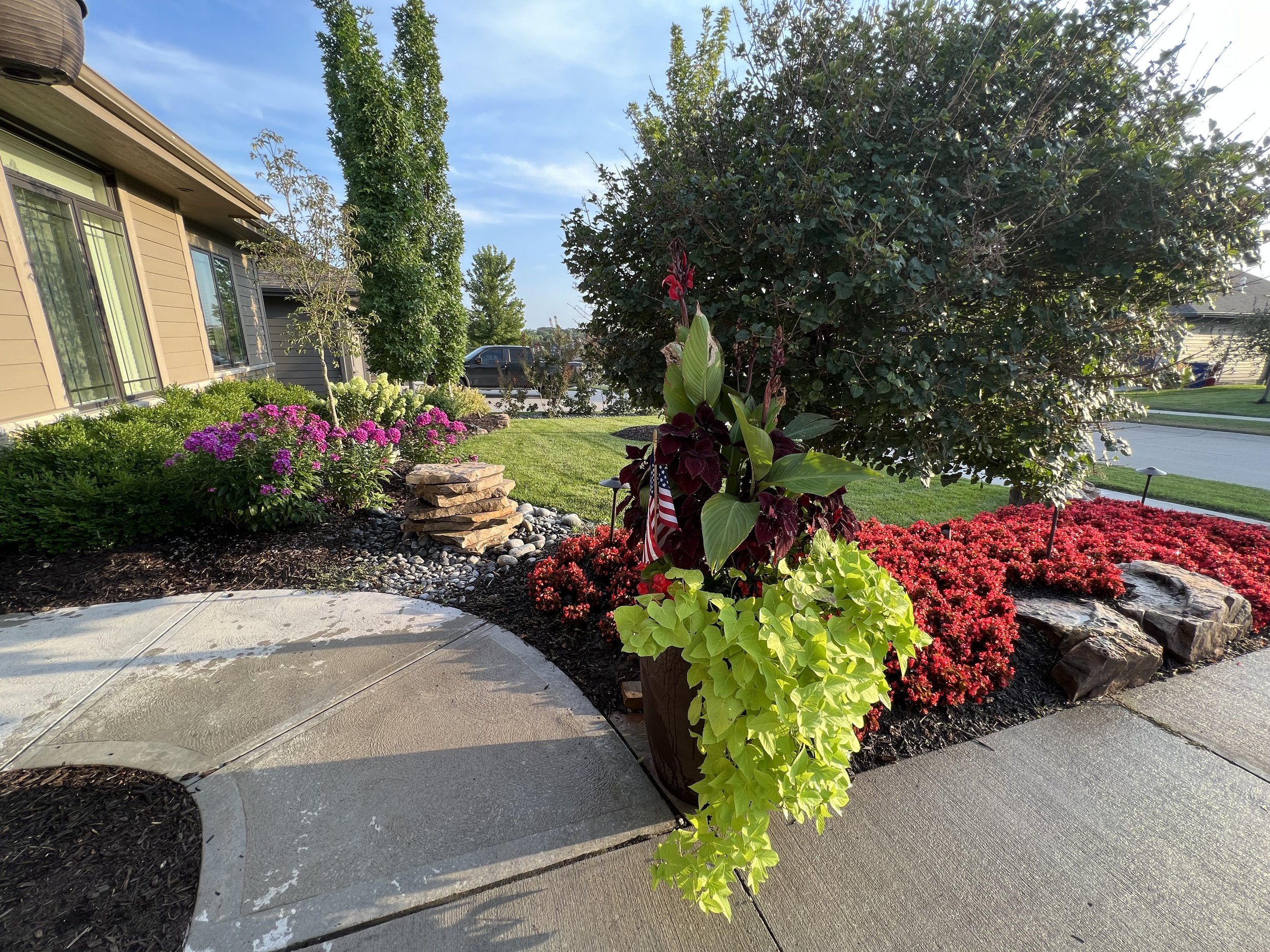SOFTSCAPING
Softscaping refers to the live, horticultural elements in landscaping that involve the use of plants, trees, flowers, soil, and other organic materials. Unlike hardscaping, which involves non-living, structural features, softscaping focuses on creating a lush, green environment and enhancing the natural aspects of outdoor spaces.

Softscaping is a pivotal aspect of landscaping that revolves around the living, horticultural elements used to enhance the beauty, functionality, and ecological balance of outdoor spaces. Unlike hardscaping, which involves non-living features like stone structures and pathways, softscaping focuses on the vibrant and dynamic components of landscaping, including plants, trees, flowers, soil, and other organic elements. It's the artful integration of these living elements that brings warmth, texture, and a sense of harmony to outdoor environments.
At its core, softscaping is about creating a living canvas that evolves and matures over time, adapting to the changing seasons and providing a connection to nature. The process begins with thoughtful planning and design, considering factors such as climate, soil conditions, sunlight exposure, and the overall aesthetic goals of the property owner.
One of the primary elements of softscaping is the selection and arrangement of plants. This includes a diverse range of plant types, from ornamental flowers and shrubs to trees and groundcovers. Each plant is chosen not only for its visual appeal but also for its compatibility with the local climate and the specific conditions of the site. Proper placement and spacing are essential to ensure optimal growth, balance, and a natural flow within the landscape.
Flower beds and gardens are key components of softscaping, offering opportunities for creative expression and seasonal variety. These areas are carefully planned to showcase a colorful array of flowers, each chosen for its bloom time, texture, and compatibility with surrounding plants. The strategic combination of perennials and annuals ensures a continuous display of vibrant colors and textures throughout the changing seasons.
Lawns are another fundamental aspect of softscaping, providing open green spaces for recreation and relaxation. The establishment and maintenance of a healthy, lush lawn involve practices such as seeding, sodding, regular mowing, and proper fertilization. Lawns contribute to the overall aesthetic of a landscape, offering a smooth and inviting surface that complements the surrounding plantings.
Mulching is a softscaping technique that involves covering the soil surface around plants with a layer of organic or inorganic materials. This not only adds a neat and uniform appearance to the landscape but also serves practical purposes. Mulch helps retain soil moisture, suppress weeds, regulate soil temperature, and improve overall soil health. Common mulching materials include wood chips, bark, straw, and rocks.
Soil preparation is a foundational step in softscaping, ensuring that the ground provides an ideal environment for plant growth. This may involve amending the soil with organic matter, compost, or other soil conditioners to enhance fertility and structure. Healthy soil is essential for supporting the roots of plants, promoting nutrient uptake, and fostering overall plant vitality.
Irrigation systems play a crucial role in softscape maintenance, providing efficient and consistent watering to keep plants healthy and thriving. Whether through drip irrigation, sprinklers, or other watering methods, a well-designed irrigation system ensures that each plant receives the appropriate amount of water, reducing water wastage and promoting sustainable landscape practices.
Seasonal maintenance is an ongoing aspect of softscaping, involving tasks such as pruning, trimming, and deadheading to keep plants in optimal condition. Pruning encourages healthy growth, controls the size and shape of plants, and removes dead or diseased branches. Regular maintenance also includes fertilization, pest control, and addressing any issues that may arise to ensure the continued vibrancy and vitality of the softscape.
Softscaping is not merely about individual plants but also about creating a cohesive and harmonious landscape. Design principles such as balance, proportion, and unity come into play to ensure that the various softscape elements work together seamlessly. The careful arrangement of plants, the consideration of color schemes, and the integration of diverse textures contribute to the overall visual appeal and aesthetics of the outdoor space.
The environmental benefits of softscaping are substantial. Plants contribute to improved air quality by absorbing carbon dioxide and releasing oxygen. They also provide habitat and food sources for wildlife, supporting biodiversity. Additionally, softscaping helps with soil erosion control, reduces noise pollution, and contributes to the overall health of the ecosystem.
In conclusion, softscaping is the living, breathing heart of landscaping. It goes beyond mere aesthetics, offering a dynamic and evolving canvas that reflects the beauty of nature. From carefully chosen plants to well-manicured lawns and thoughtfully designed gardens, softscaping transforms outdoor spaces into inviting and harmonious environments. It not only enhances the visual appeal of a property but also fosters a deeper connection with the natural world, providing a sanctuary for relaxation, contemplation, and enjoyment of the great outdoors.
